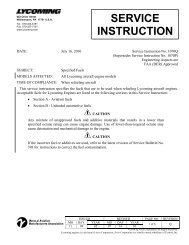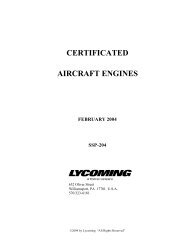You also want an ePaper? Increase the reach of your titles
YUMPU automatically turns print PDFs into web optimized ePapers that Google loves.
7. Automotive fuel used in an aircraft engine may lead to destructive<br />
detonation or preignition and potential engine failure at high<br />
power conditions.<br />
8. Please review the Mo-Gas fuel requirements in your state or<br />
destination.<br />
SUMMARY:<br />
Auto fuel is now being used as a substitute for Grade 80 aviation<br />
gasoline under STCs issued by the FAA. Most major oil companies<br />
and engine manufacturers continue to recommend that<br />
aircraft piston engines be operated only on aviation gasoline.<br />
Deterioration of engine and fuel system parts have been reported<br />
in aircraft using auto fuel. Operators should consider the added risk<br />
of using auto fuel in aircraft. Remember — a pilot can’t pull over<br />
to the side of the road when fuel creates a problem with the engine.<br />
The advent of the lightweight turbocharger has been called the<br />
shot of adrenaline which the piston engine needed to remain the<br />
prime method of powering general aviation-type aircraft. Although<br />
in some respects this may be an overstatement, it does have much<br />
merit, and it is the lightweight turbocharger that has enabled<br />
general aviation aircraft to operate above adverse weather in the<br />
smooth air of the higher altitudes, and to realize that increased true<br />
air speed is not possible with normally aspirated engines. So this<br />
is the “why” of turbocharging, and since it is possible that there<br />
is a turbocharged <strong>Lycoming</strong> engine in your present or future, we<br />
are going to review the very basics of turbocharging and bring the<br />
reader up to the present “state of the art” of it.<br />
The aircraft engine, as any reciprocating engine, is a heat engine<br />
which derives its power from the burning of a mixture of air<br />
and fuel, which has been mixed in the proper proportions by a<br />
fuel-metering device. The amount of power the engine develops<br />
will be directly proportional to the total mass of air pumped<br />
through the engine, providing the fuel/air ratio is kept constant.<br />
This can be varied in a normally aspirated (unturbocharged)<br />
engine by changing the throttle setting and/or changing the RPM.<br />
Let us go over that again. Changing the throttle will vary the manifold<br />
pressure available to the cylinder during the intake stroke.<br />
As a result, the cylinder will develop a given amount of power<br />
on each power stroke. So if we increase manifold pressure to the<br />
cylinder, we will in turn receive more power from the engine.<br />
Now if we keep the manifold pressure constant, but increase the<br />
number of power strokes by increasing the RPM, we will also<br />
receive more power from the engine. We see that changing either<br />
the throttle setting (manifold pressure) or the number of power<br />
strokes per minute (RPM), will result in varying the total air mass<br />
flow through the engine and will determine the horsepower the<br />
engine will develop. So in essence, a reciprocating engine is also<br />
an air pump, and if the fuel/air ratio is kept constant, the power<br />
developed will vary directly with the mass of air consumed.<br />
We are limited in the speed at which we can operate the engine<br />
because of engine and prop mechanical limitations. So the only<br />
8 L y c o m i n g F l y e r<br />
other way to change the mass flow is to increase the manifold<br />
pressure. We all know, however, that as we ascend in altitude, the<br />
air becomes less dense which reduces the mass flow through the<br />
engine with the result of a power loss that is proportional to the<br />
reduced-mass air flow through the engine. You have noted that<br />
in climb with a normally aspirated engine, it is necessary to keep<br />
opening the throttle if you are to keep the air speed and the rate<br />
of climb constant. So we see that if there were a way we could<br />
put the engine into a container so it could be kept at sea level<br />
conditions, we could maintain the same performance regardless<br />
of ambient conditions and altitude.<br />
A long time ago, a smart engineer who was thinking along these<br />
same lines reasoned that if he built an air pump into the engine that<br />
could pump the less dense air at altitude up to the same pressure<br />
he had at sea level, he would be able to maintain sea level horsepower.<br />
So he designed a centrifugal air compressor and placed it<br />
between the fuel-metering system and the intake pipes. The pump<br />
consisted of an impeller, diffuser and collector. The impeller was<br />
driven at about 12 times crankshaft speed, and this high rotational<br />
speed imparted a large velocity of energy to the air passing<br />
through. Now as the fuel/air charge leaves the impeller, it goes to<br />
the diffuser where vanes smooth out the air flow while allowing<br />
the mixture to slow down so that the velocity pressure acquired<br />
from the rapid rotational speed of the impeller is transformed<br />
into static pressure. This air mass is then stored momentarily and<br />
equalized in the collector and is then drawn into the cylinders. Our<br />
engineer now has his air pump, but how is he to drive it? Well,<br />
he could drive it from the accessory gear train or from the rear<br />
of the crankshaft, but both of these methods robbed the engine<br />
of horsepower it could deliver to the propeller. Although superchargers<br />
for many years have been driven mechanically off the<br />
crankshaft, our engineer realized he had not reached the ultimate<br />
in the “state of the art” of supercharging, so he began looking for<br />
another means of driving his air pump.<br />
Our hypothetical engineer realized that the largest percent of<br />
energy released by burning the fuel/air mixture was going out<br />
of the exhaust pipe in the form of heat. Realizing if he could in<br />
some way harness this wasted energy to drive his air pump, the<br />
horsepower normally robbed from the engine to drive the impeller<br />
could be used by the propeller.<br />
We have all seen a windmill turning in the breeze, so our engineer<br />
rightfully reasoned if he put a turbine wheel in the exhaust stream,<br />
he could take the hot exhaust gas under pressure and expand<br />
it as it passed through the wheel to extract energy. He took an<br />
impeller, connected it by a common shaft to the turbine, and he<br />
had a means of driving his air pump by energy which was formerly<br />
going to waste. Supercharging by means of using exhaust<br />
gases to drive the air pump is called turbocharging. Now our<br />
engineer had progressed to the point where he required a means<br />
of controlling his turbocharger. As he climbed in altitude the<br />
pump must constantly put out a higher pressure ratio in order to<br />
maintain sea level conditions. He reasoned that if he can dump<br />
the exhaust gas at sea level through a butterfly valve in a leg off<br />
the exhaust pipe and ahead of the turbine wheel, he will be able<br />
to control the amount of energy being used to drive the turbine<br />
and thus control the speed of the compressor.







